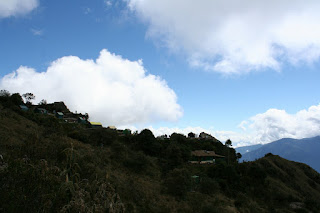That said, after a breakfast of toast, jam, and scrambled eggs, we started shortly before 7am with a steep climb up to Runkurakay. The name means 'oval ruins' and, as many other Quechua-named Inca sites, was given a rather prosaic monicker that is descriptive. Nobody knows the true names and so they are named by their discoverers - or, more likely, by the indigenous person that brought them to it.
 |
| Runkurakay |
Runkurakay was a stopping place rather than a true settlement, with a narrow entrance to protect the llamas from predators (such as foxes and pumas). Llamas have been very important to the Andean people - being used for clothing and other textiles, for meat, and in offerings to Pachamama - but they were also used in war. The so-called 'Wizard of the Andes' deployed the beasts in battle with Chile during the War of the Pacific to bolster his troops numbers. Each soldier brought a llama dressed with a hat to hide the ears, a poncho and a stick tied across its back so as to appear as a rifle. With the dust kicked up in the advance, this fooled the enemy and Peru won that particular battle.
The next stage took us downwards to Sayakmarka, or the 'hidden town'. This impressive, fortress-like town had an imposing position looking out into the valley and was on the route from Vilcabamba and from Machu Picchu.
 |
| Sayakmarka |
The route continued, a rocky path cut into the side of the mountain. This was easily the most impressive and authentic section of original trail, having not been destroyed by landsides and such. The path even cut into the mountain at times, forming small tunnels.
 |
| Camino del Inka |
Lunch was prepared at Phuyupatamarka with our first view across to Machu Picchu mountain and down to the town of Aguas Calientes. The name of the place means 'town in the clouds', which was apt given the white clouds scudding about at this altitude - in the rainy season the peak would be above them.
 |
| Approaching Phuyupatamarka |
 |
| Lunch in the sky |
Being the last lunch, the cook pulled out all the stops, creating lomo saltado with fake meat (for the vegetarians), rice, fried potatoes and vegetables, as well as a mushroom pizza and then, the pièce de resistance, a cake. This had been baked in the morning and transported to the lunch spot unharmed. It was an incredible culinary feat in such a remote location.
 |
| Gourmet wizardry |
Today, lunch did not signal the end of the day's trek, as we still had 4 of the 16km to walk. Still, Machu Picchu was in sight - at least, the mountain bearing that name was visible, marked by a flag at its summit, while the town lay hidden behind its peak. I also, now we were in proximity to Aguas Calientes town and had signal, was able to speak to K - referred to as "la flojita" (the little ill one) by our guide - to check that she was well enough to join us tomorrow. She was.
 |
| Spot Machu Picchu! |
The trail took us yet farther down, descending 1000m in elevation by steep Inca steps, through a rapidly changing ecology and increasing humidity. The environment on this side of the mountain is sub-tropical, signified by paths shaded by green vegetation, including bamboo familiar to us from treks in SE Asia.
Familiar terraced steps indicated another Inca ruin - increasing in concentration around Machu Picchu - and an astonishing view down to our old friend, the Urubamba river.
We reached camp at Wiñayhuayna at 3:30pm. The tents were pitched on a terraced site overlooking the Urubamba valley.
With barely ten minutes to rest our feet, we promptly marched downhill to visit the ruined town that gives its name to the camp. Actually, the site was not that ruined, being instead a stunning example of houses with pitched roofs. The name, meaning 'forever young' reflects how well preserved the structures are, which were only discovered in 1941.
 |
| Wiñayhuayna |
Terraces are present, both to prevent landslide and, presumably, for agriculture. Channels alongside the terraces and houses show that water flowed through the town, and a beautiful waterfall still cascades a few steps from the site.
 |
| Wiñayhuayna waterfall |
Back at camp, a surprise tea time was laid on as we had arrived so early. Dinner followed, with the soup being accompanied by garlic bread - leading us to question where the chef manages to prepare not only bread, but cake and pizza too - after which came rice, vegetables and fried yuca.
At a lower altitude and in the sub-tropical cloud forest, it was a mercifully much warmer night in the tent.
No comments:
Post a Comment